Your cart is currently empty!
Persian Rugs designs: The Timeless Art of Handwoven Luxury
The enchanting beauty of Persian rugs, with their rich colors and intricate patterns, holds a prestigious place in traditional folk art. Throughout history, Persian carpets have been a reflection of culture and artistry, deeply rooted in the lives of villagers, city dwellers, and nomadic tribes across Iran.
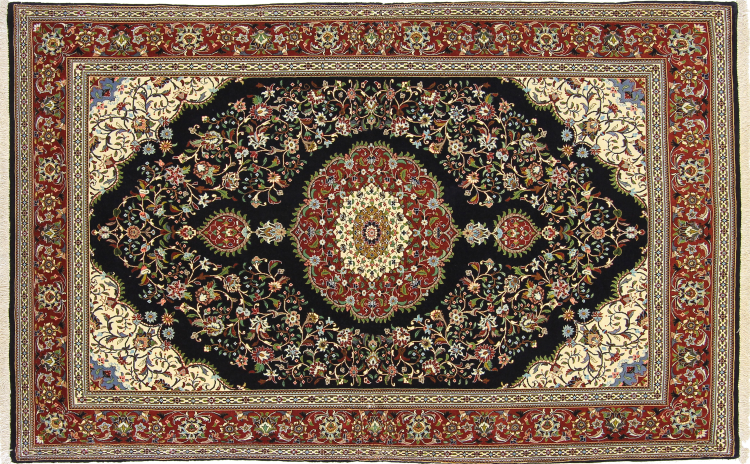

The enchanting beauty of Persian rugs, with their rich colors and intricate patterns, holds a prestigious place in traditional folk art. Throughout history, Persian carpets have been a reflection of culture and artistry, deeply rooted in the lives of villagers, city dwellers, and nomadic tribes across Iran. The geographical diversity of this craft has resulted in distinct weaving techniques and styles, each region showcasing its own unique patterns, symbolism, and craftsmanship, making Persian rugs an unparalleled heritage of elegance and tradition.
This prestige has been achieved through the harmony of colors and patterns. In each region, colors and motifs have developed their own unique local characteristics, which, along with the distinct technical features of each area, allow for the identification and differentiation of Persian carpets.
The diversity of designs and motifs in Persian carpets is so vast that it is considered the strongest and most defining artistic feature of these masterpieces.
In this article, we will provide a brief introduction to the different patterns and designs found in Persian carpets.
In general, various classifications have been proposed for patterns and designs in Persian carpets. Here, I will introduce the 19-category classification presented by the Iran Carpet Joint Stock Company. According to their classification, Persian carpet designs are divided into 19 main groups, along with numerous subcategories, which include:
1- Ancient Monuments and Islamic Architecture Designs
These designs are inspired by architectural structures, tilework, geometric patterns, and decorative elements found in historic buildings. Throughout history, carpet designers have made modifications to original patterns, leading to the creation of subcategories and variations.
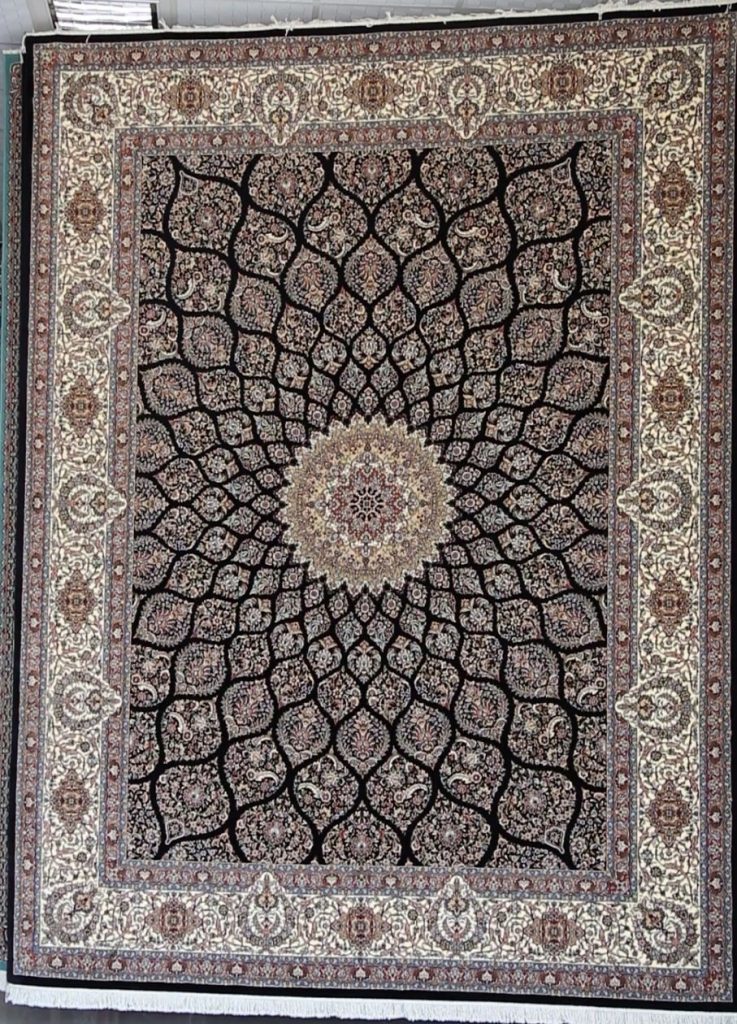
Some of the most famous architectural inspirations in this category include:
- Sheikh Lotfollah Mosque
- Kufic Mihrab Design
- Blue Mosque (Masjed-e Kabud)
- Sheikh Safi Mausoleum
- Entrance of Imamzadeh Mahrooq
- Gonbad-e Qabus (Qabus Dome)
- Shah Mosque of Isfahan
- Persepolis (Takht-e Jamshid)
- Taq-e Bostan
- Taq Kasra (Iwan-e Mada’in)
- Ancient Excavation Motifs
2- Shah Abbasi Carpet Designs
The foundation of all Shah Abbasi carpet designs is based on the use of the famous Shah Abbasi floral motif. These designs incorporate Shah Abbasi flowers along with Khatai vine patterns, sometimes blended with Islimi (arabesque) motifs, creating a variety of distinct carpet patterns.
The main types of Shah Abbasi designs include:
- Lachak Toranj Shah Abbasi (Medallion and Corner Shah Abbasi)
- Afshan Shah Abbasi (Scattered Shah Abbasi)
- Shah Abbasi Tree Design
- Shah Abbasi Sheikh Safi Design
- Shah Abbasi Animal Motif Design
- And many more variations.
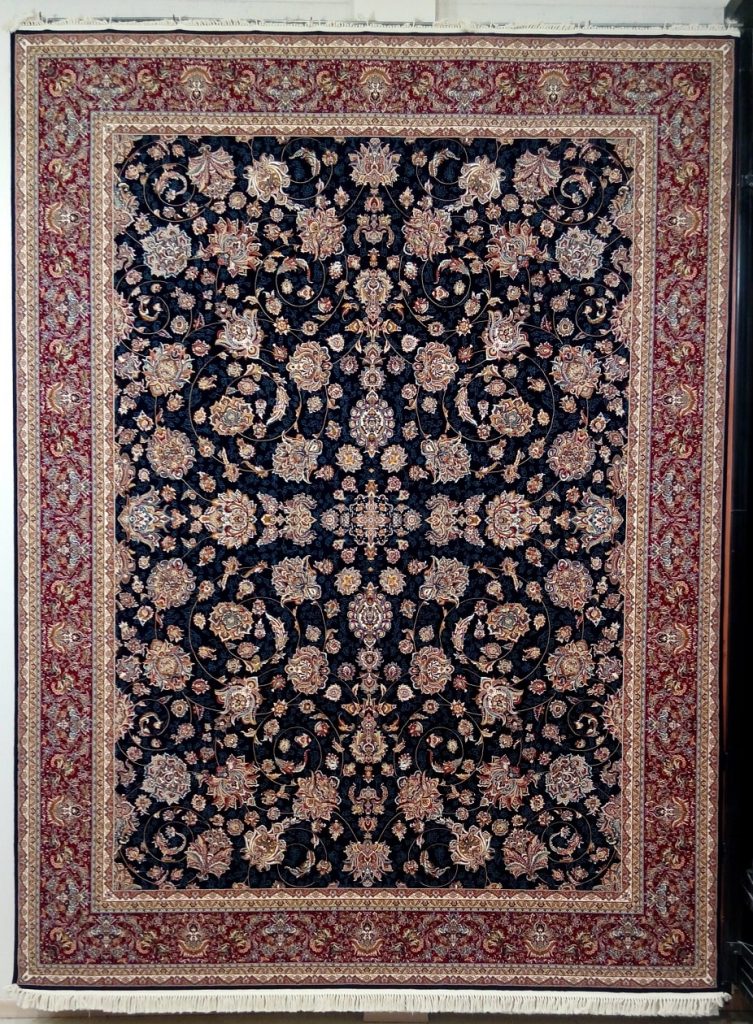
3- Islimi (Arabesque) Carpet Designs
The core structure of Islimi (Arabesque) carpet designs consists of curved, swirling branches intertwined with leaves. These branches are stylized representations of tree forms, creating a flowing and dynamic composition.
Islimi patterns come in various forms, and while they frequently appear as decorative elements in many designs, some carpets feature them as the dominant motif.
One of the most famous variations is the “Dragon’s Mouth Islimi” (Islimi Dahan Azhdar). In this style, the end of each branch splits symmetrically into two sections, resembling a dragon’s open jaws. Additionally, small buds appear along the branches, which are often referred to as “Islim” elements. Some scholars suggest that the term “Islimi” originates from “Islim” (meaning bud), while others believe it is derived from “Islami” (Islamic), as this motif is widely used in Islamic art.
Due to its variability and artistic adaptations, Islimi patterns have been divided into several subcategories, including:
- Islimi (Classic Arabesque)
- Islimi Bandi (Interwoven Arabesque)
- Islimi Shekasteh (Broken Arabesque)
- Islimi Dahan Azhdar (Dragon’s Mouth Arabesque)
- Islimi Lachak Toranj (Medallion and Corner Arabesque)
- Islimi Toranj Dar (Medallion Arabesque)
- Islimi Mari (Serpentine Arabesque)
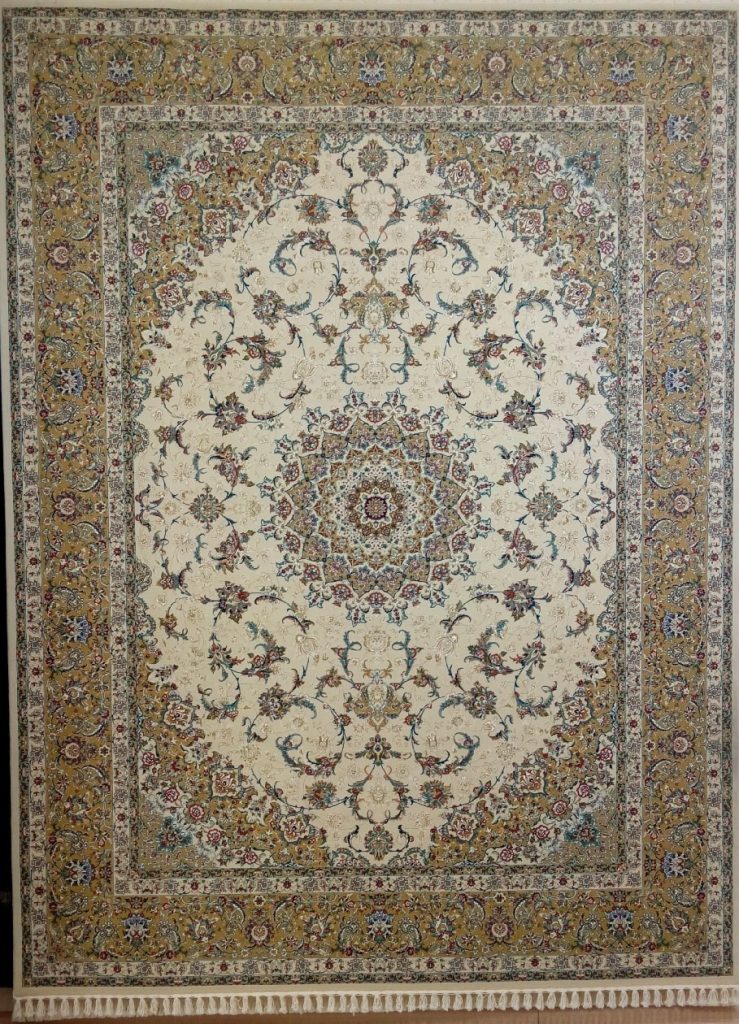
4- Afshan Carpet Designs
In Afshan carpet designs, all the patterns and motifs are interconnected, creating a continuous and flowing composition. It appears as though the artist never lifted their pen from the paper while designing, maintaining seamless connections between different elements.
As the name suggests, the flowers, leaves, and vines in this design are scattered (Afshan) across the field of the carpet in a free-flowing manner. Unlike many traditional Persian carpet patterns, Afshan designs do not follow strict symmetry, meaning no two floral or leaf motifs are perfectly mirrored.
There are several subtypes of Afshan designs, including:
- Afshan Dasteh Goli (Bouquet Afshan)
- Afshan Heyvan Dar (Animal Motif Afshan)
- Afshan Toranji (Medallion Afshan)
- Afshan Khataei (Khatai Floral Afshan)
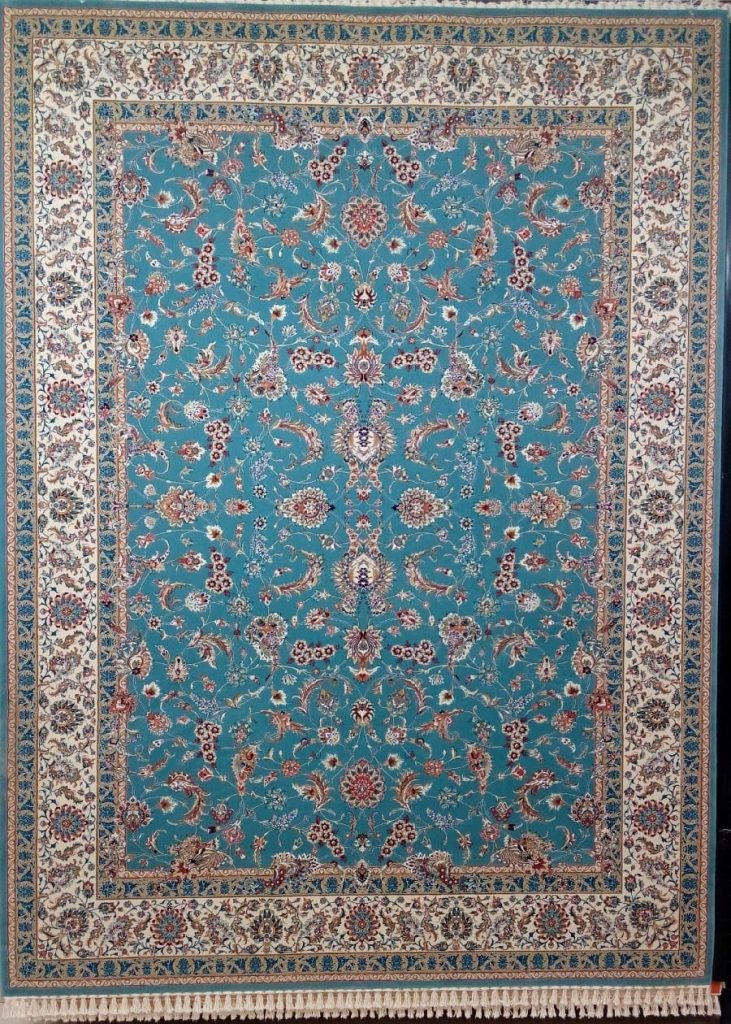
5- Boteh (Paisley) Carpet Designs
The Boteh (Paisley) design is a stylized representation of the cypress tree, symbolizing eternity and resilience. The curved Boteh motifs found in Persian carpets, commonly known as Boteh-Jegheh, appear in various sizes and forms within these designs.
Some of the most famous Boteh carpet designs include:
- Boteh-Jegheh (Classic Paisley Boteh)
- Boteh Shakh Gavazn (Deer Antler Boteh)
- Boteh Termeh (Termeh Paisley Boteh)
- Boteh Sarabandi (Saraband Paisley)
- Boteh Kherqe’i (Sufi Cloak Boteh)
- Boteh Ghalamkar Esfahan (Esfahan Block-Printed Boteh)
- Hasht Gol (Eight-Flower Boteh)
- Boteh Kurdistani or Hasht Boteh (Kurdistan Paisley)
- Boteh Mir Shekasteh (Broken Mir Boteh)
- Boteh Lachak Toranj (Medallion and Corner Boteh)
- Boteh Sanandaj (Sanandaj Paisley)
- Boteh Afshari (Afshari Tribe Boteh)
- Boteh Bazobandi (Armlet Boteh)
- Boteh Badami (Almond-Shaped Boteh)
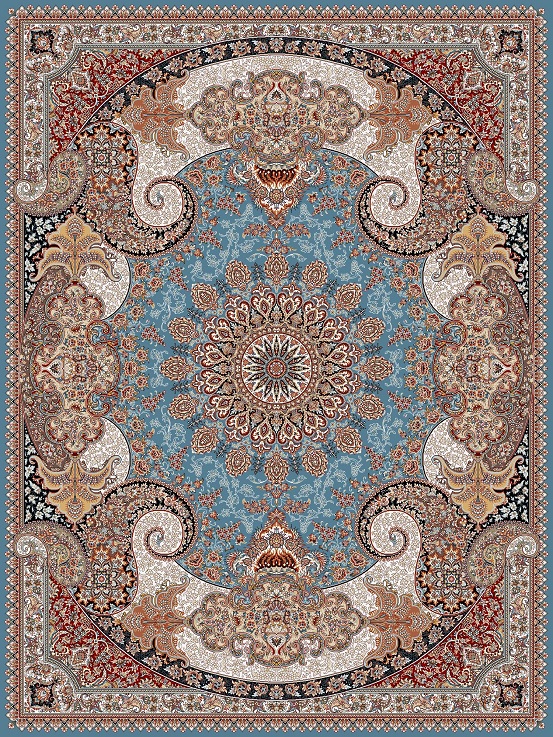
6- Adapted (Inspired) Carpet Designs
It is said that most designs in this category bear a strong resemblance to the carpet patterns of Iran’s border regions, as well as those of neighboring and even distant countries. This is why they are referred to as “Adapted” or “Inspired” designs. Some of the most well-known patterns in this category include Caucasian (Ghafghazi) designs and Gobelin-style designs.
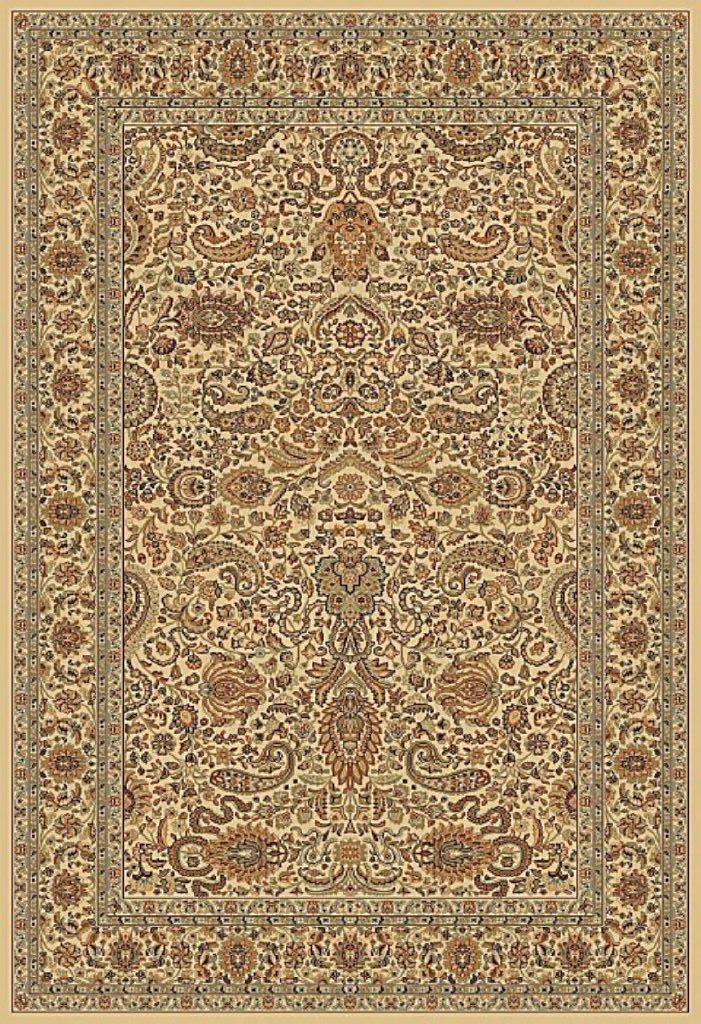
7- Vagireh (Bandi) Carpet Designs
The term “Bandi” (Repeated or Vagireh Design) refers to a small segment of a pattern that is repeated throughout the entire carpet, both horizontally and vertically. Since these repeating elements interconnect, the pattern is called Bandi (modular design) or Vagireh (repeat unit design).
Some of the subcategories of this design include:
- Bandi Islimi (Arabesque Repeat Pattern)
- Bandi Pichak (Ivy Repeat Pattern)
- Bandi Shekasteh (Broken Repeat Pattern)
- Bandi Katibeh (Calligraphic Repeat Pattern)
- Bandi Mostofi (Mostofi Repeat Pattern)
- Bandi Varamin or Minakhani (Varamin Floral Repeat Pattern)
- Bandi Ghaleb Kheshti or Loz (Brick or Diamond Repeat Pattern)
- Bandi Toranj Dar (Medallion Repeat Pattern)
- Bandi Derakhti (Tree Repeat Pattern)
- Bandi Ghabaqabi (Panel Repeat Pattern)
- Bandi Shir Shakari or Bazobandi (Sugar Lion or Armband Repeat Pattern)
- Bandi Sarvi (Cypress Tree Repeat Pattern)
- Bandi Adamaki or Molla Nasreddin (Figurative or Molla Nasreddin Repeat Pattern)
- Bandi Bakhtiari (Bakhtiari Repeat Pattern)
- Bandi Majlesi (Ceremonial Repeat Pattern)
- Bandi Khoshe Angoori (Grape Cluster Repeat Pattern)
- Bandi Shakhe Gavazn Heyvandari (Deer Antler Animal Motif Repeat Pattern)
- Bandi Khatam Shirazi (Shiraz Inlay Repeat Pattern)
- Bandi Daste Gol (Bouquet Repeat Pattern)
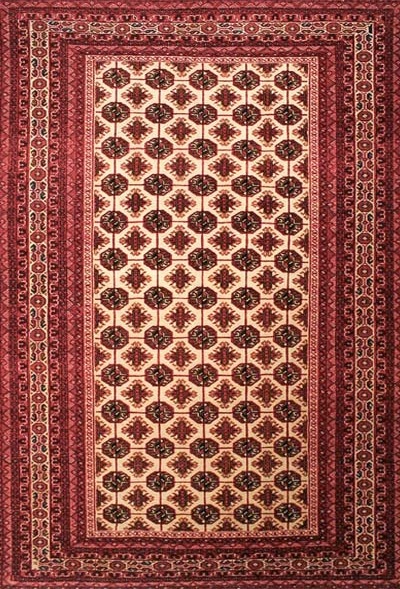
8- Tree Motif Carpet Designs
Although branches and leaves form the foundation of carpet design, tree motif carpets aim to closely resemble natural landscapes. These designs emphasize a realistic depiction of trees and foliage, maintaining a strong connection to nature.
Some of the most well-known tree motif designs include:
- Derakhti Heyvan-Dar (Tree with Animal Motifs)
- Derakhti Sabzikar or Abnama (Tree with Garden or Fountain Motif)
- Derakhti Toranj-Dar (Tree with Medallion Design)
- Derakhti Sarvi (Cypress Tree Design)
- Derakhti Goldani (Tree with Vase Motif)

9- Turkmen carpet designs
The Turkmen carpet designs are categorized as tribal and nomadic patterns, characterized by geometric shapes and angular lines. These carpets are woven from memory, without the use of pre-drawn patterns, reflecting the artistic intuition and cultural heritage of Turkmen nomads.
Some of the most well-known subcategories of Turkmen designs include:
- Turkmen Ghabi Yamoni (Yamoni Panel Design)
- Turkmen Shane’i (Comb Motif Design)
- Turkmen Ghazal Gaz (Deer’s Eye Motif)
- Turkmen Akhal (Akhal Region Design)
- Turkmen Chahar Ghabi (Four-Panel Design)
- Turkmen Khorjini (Saddlebag Motif Design)
- Turkmen Ghashoqi (Spoon Motif Design)
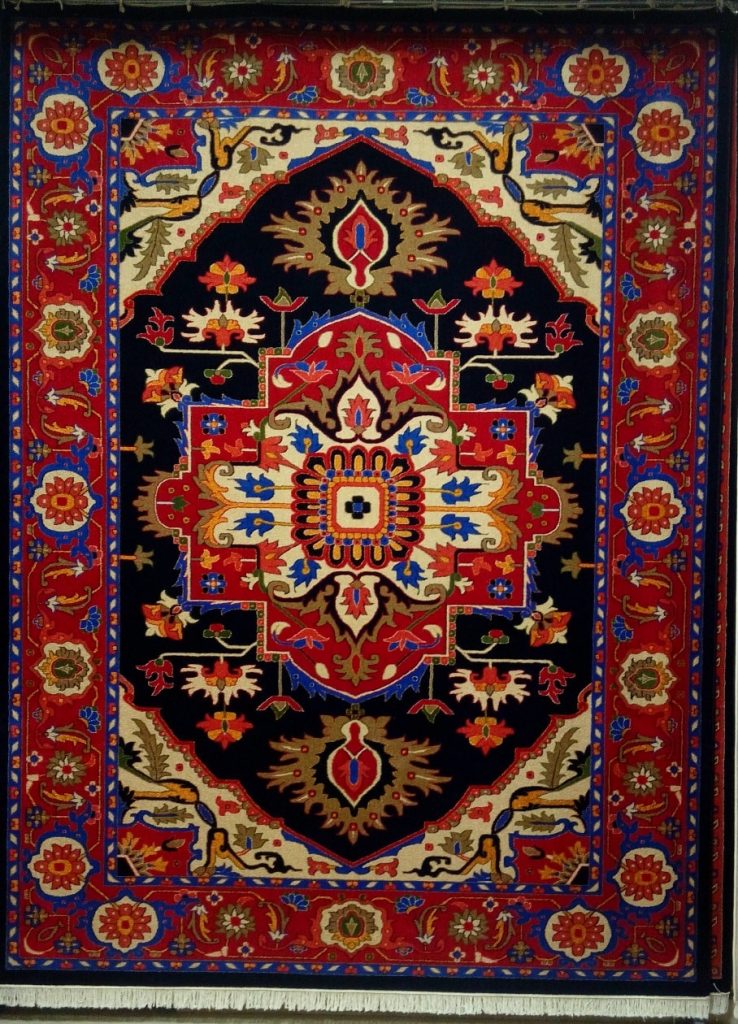
10- Hunting Scene Carpet Designs
The foundation of this design category is the depiction of hunting scenes and game reserves. Various sections of the pattern showcase horsemen engaged in hunting deer or other animals using bows, arrows, or spears.
The subcategories of Hunting Scene designs include:
- Shikargah Derakhti (Tree Hunting Scene)
- Shikargah Toranj-Dar (Medallion Hunting Scene)
- Shikargah Ghabi (Framed Hunting Scene)
- Shikargah Lachak Toranj (Corner and Medallion Hunting Scene)
- Shikargah Sarasari (All-over Hunting Scene)
Currently, Hunting Scene designs are also widely used in pictorial carpets (tableau rugs), making them popular for decorative wall art.
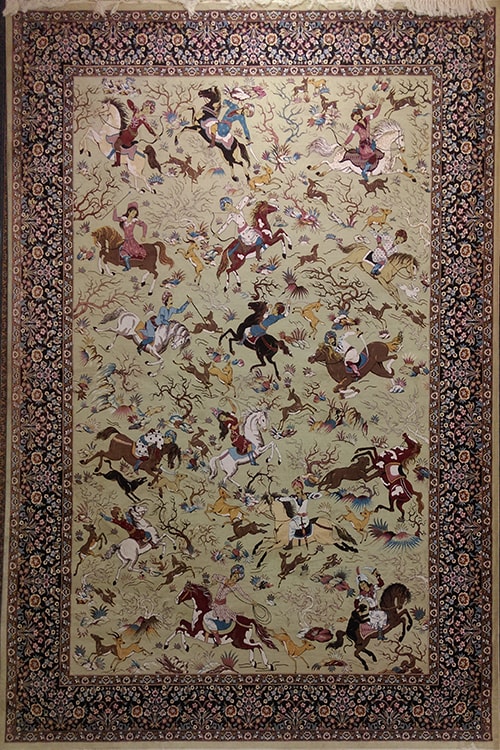
11- Panel (Kheshti) Carpet Designs
In this design, the carpet field is divided into multiple rectangular or square panels (frames), which are systematically arranged next to each other. Each panel is decorated with various floral motifs, leaves, or intricate patterns, creating a harmonious and structured layout.
Some of the subcategories of Panel (Kheshti) designs include:
- Ghabi Islimi (Arabesque Panel Design)
- Ghabi Qur’ani Kermani (Quranic Panel Design from Kerman)
- Ghabi Sotuni (Column Panel Design)
This pattern is particularly popular in Persian rugs, adding a sense of organization and aesthetic symmetry to the design.
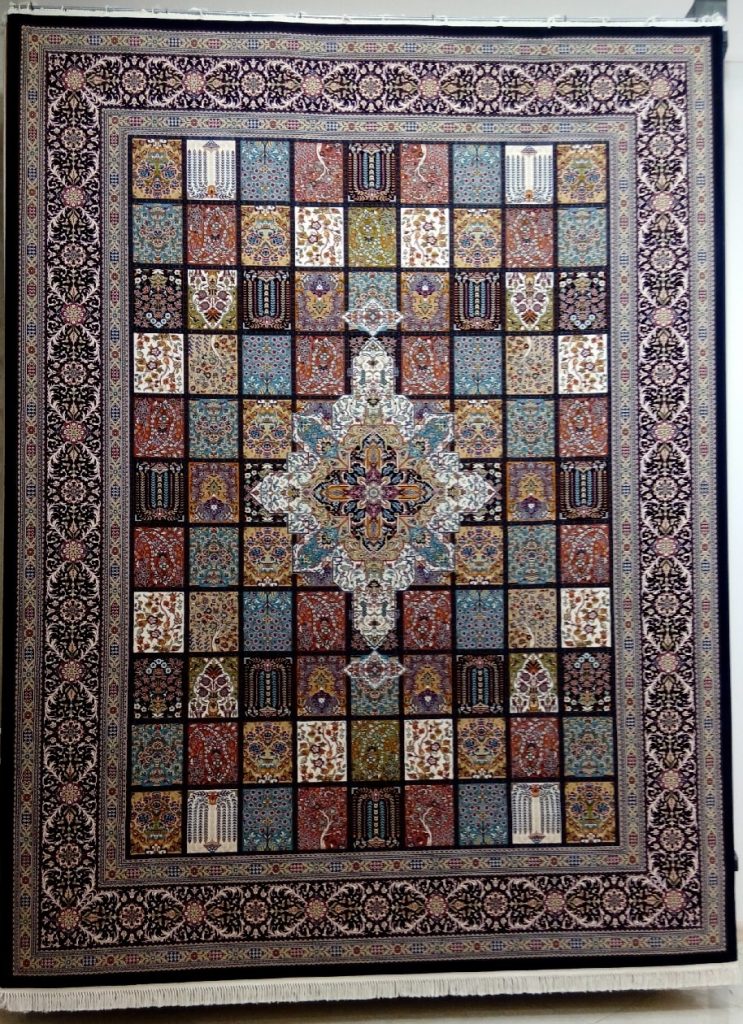
12- Gol Farang (European Floral) Carpet Designs
All designs in this category are inspired by natural flowers, particularly roses, depicted in soft and bright colors such as yellow, blue, and red. This design style reflects a European influence, blending Persian craftsmanship with Western floral aesthetics.
Some of the subcategories of Gol Farang (European Floral) designs include:
- Gol Farang Bijar (Bijar European Floral Design)
- Gol Farang Dasteh Goli (Bouquet Floral Design)
- Gol Farang Gol o Bolbol (Flower and Nightingale Design)
- Lachak Toranj Gol Farang (Medallion and Corner European Floral Design)
- Afshan Gol Farang (Scattered Floral European Design)
These designs are particularly admired for their delicate, decorative appeal, making them popular choices in Persian carpets.
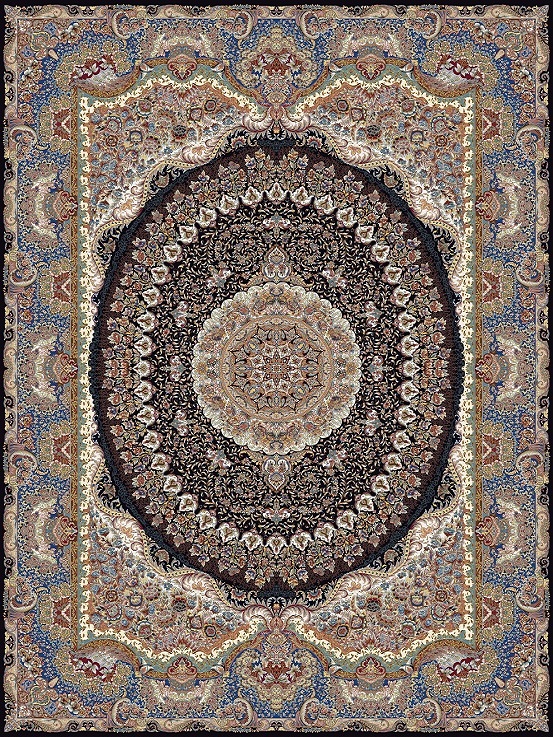
13- Vase (Goldani) Carpet Designs
In the Vase (Goldani) carpet design, vases of various sizes are prominently featured. Sometimes, a large flower-filled vase dominates the entire carpet, while in other cases, multiple smaller vases are arranged symmetrically around the field or repeated throughout the design.
Some of the subcategories of Vase designs include:
- Goldani Khataei (Floral Vine Vase Design)
- Goldani Do-Tarafeh (Double-Sided Vase Design)
- Goldani Mehrabi (Mihrab Vase Design)
- Goldani Sarasari (All-Over Vase Design)
- Goldani Zill al-Sultan (Flower & Nightingale Vase Design)
- Goldani Haj Khatami (Haj Khatami Vase Design)
- Goldani Tekrari (Repeated Vase Design)
- Goldani Lachak Toranj (Medallion and Corner Vase Design)
- Goldani Yek-Tarafeh (Single-Sided Vase Design)
These designs, rich in floral motifs and symmetry, are among the most elegant and decorative Persian carpet patterns.
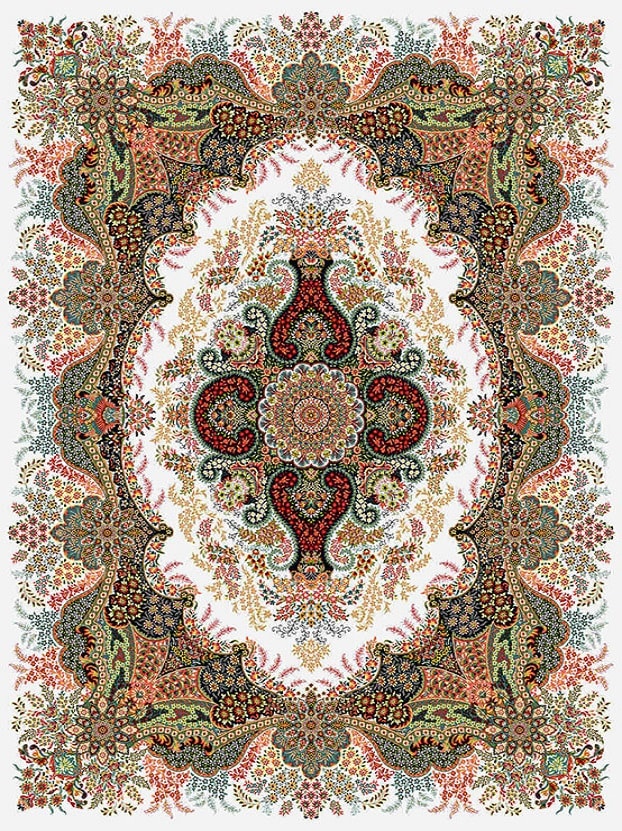
14- Mihrabi (Prayer Niche) Carpet Designs
The main concept of this design category is based on the Mihrab (prayer niche), which is the sacred space in mosques where the prayer leader stands. In these carpet designs, the Mihrab is often adorned with decorative elements such as hanging lamps (Qandil), vases, and even small trees. In some variations, large columns are depicted on either side of the Mihrab, supporting the arched ceiling of the niche.
Some of the subcategories of Mihrabi designs include:
- Mihrabi Qandili (Prayer Niche with Hanging Lamp Design)
- Mihrabi Goldani (Prayer Niche with Vase Design)
- Mihrabi Derakhti (Prayer Niche with Tree Motif)
These designs are deeply symbolic and spiritual, making them popular choices for prayer rugs and mosque carpets.
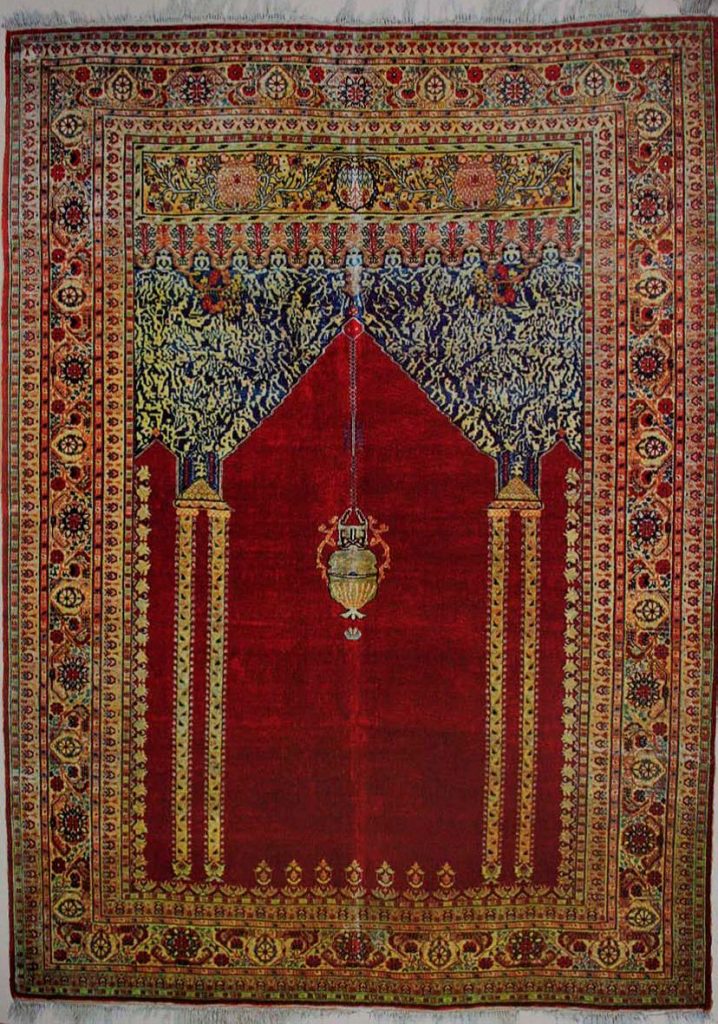
15- Mahi Darham (Intertwined Fish) Carpet Designs
The Mahi Darham (Intertwined Fish) design is one of the oldest and most popular Persian carpet patterns. It is typically designed as a repeating module (Vagireh pattern), meaning the weaver replicates the same motif across the length and width of the carpet.
This pattern features a diamond-shaped central pool motif, surrounded by four leaves, with fish-like elements woven around it. The Mahi Darham design is known by different names in various regions of Iran, with some of the most notable variations including:
- Mahi Herati (Herat Fish Design)
- Mahi Farahan (Farahan Fish Design)
- Mahi Zanboori (Honeycomb Fish Design)
- Mahi Kurdistani (Kurdistan Fish Design)
- Zire Mahi (Underwater Fish Design)
This intricate and timeless design continues to be one of the most recognizable and admired motifs in Persian carpet weaving.
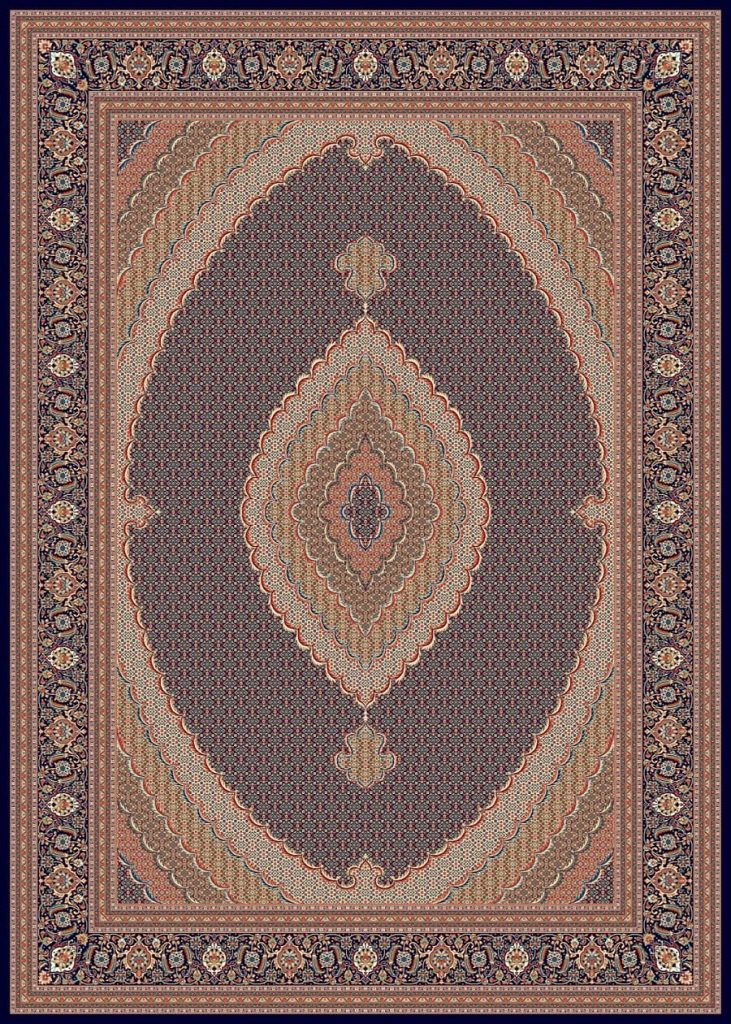
16- Moharramat (Striped) Carpet Designs
The Moharramat (Striped) carpet design refers to patterns in which segments of a motif are repeated lengthwise across the carpet. The width of the carpet is divided into multiple vertical bands, each featuring a distinct color and pattern that continues from one end to the other in a striped arrangement.
In some regions of Iran, this design is also known as “Ghalam-Dani” (Pen Case Design).
The subcategories of Moharramat designs include:
- Ghalam-Dani Sarasari (All-over Pen Case Design)
- Gol Riz Ba Zamineh Yek Rang (Small Floral Motif with Solid Background)
- Boteh Ba Zamineh Alvan (Paisley with Multi-Colored Background)
This pattern is widely used in Persian carpets and is particularly favored for its orderly, elegant structure
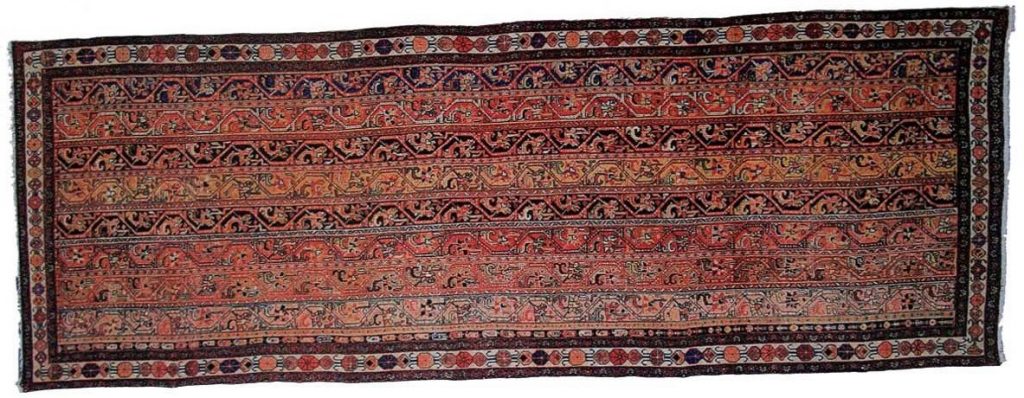
17- Geometric Carpet Designs
In Geometric carpet designs, various geometric shapes are used, with angled lines dominating the patterns. Unlike floral or arabesque designs, these patterns do not incorporate curved or circular motifs; instead, they feature sharp, structured, and symmetrical compositions.
Some of the major subcategories of Geometric designs include:
- Hendesi Bandi Ghabi (Panel-Based Geometric Design)
- Hendesi Toranj-Dar (Medallion Geometric Design)
- Hendesi Moharramat (Striped Geometric Design)
- Hendesi Lachak Toranj (Broken Branch Medallion and Corner Geometric Design)
- Hendesi Kaf Sadeh (Plain Background Geometric Design)
- Hendesi Khataei (Khataei Geometric Design)
- Hendesi Setareh (Star or Mosaic Geometric Design)
- Hendesi Khatam Shirazi (Shiraz Inlay Geometric Design)
- Hendesi Joshqani (Joshqan Geometric Design)
These designs are particularly popular in tribal and nomadic rugs, where weavers often create intricate and symmetrical geometric patterns from memory, without using pre-drawn templates.

18- Combined (Talfighi) Carpet Designs
Over time, in addition to the established carpet designs with distinct names and rich histories, new patterns have emerged through the fusion of two or more traditional designs. These blended patterns combine elements from different styles, creating unique and innovative carpet motifs.
Some of the subcategories of Combined (Talfighi) designs include:
- Shakhe-Pich Toranj-Dar (Twisted Branch with Medallion Design)
- Selselei Toranj-Dar (Sequential Medallion Design)
- Talfighi Lachak Toranj (Combined Medallion and Corner Design)
- Goldani Band Islimi (Vase with Arabesque Border Design)
- Talfighi Ghabi Ghabi (Combined Panel-Based Design)
- Talfighi Dournama (Scenic Combined Design)
- Talfighi Toranji Daste Gol (Medallion with Bouquet Combined Design)
- Talfighi Sabzikar (Garden-Themed Combined Design)
- Talfighi Toranj-Dar (Medallion-Based Combined Design)
- Talfighi Toranji Kaf Sadeh (Medallion with Plain Background Combined Design)
- Talfighi Lachak Toranj Kaf Sadeh (Corner Medallion with Plain Background Combined Design)
- Talfighi Lachak Toranj Sabzikar Kaf Sadeh (Garden Medallion with Plain Background Combined Design)
- Talfighi Bandi Daste Gol (Bouquet with Banded Combined Design)
These designs represent a harmonious blend of Persian artistic traditions, resulting in visually captivating and complex carpet patterns.
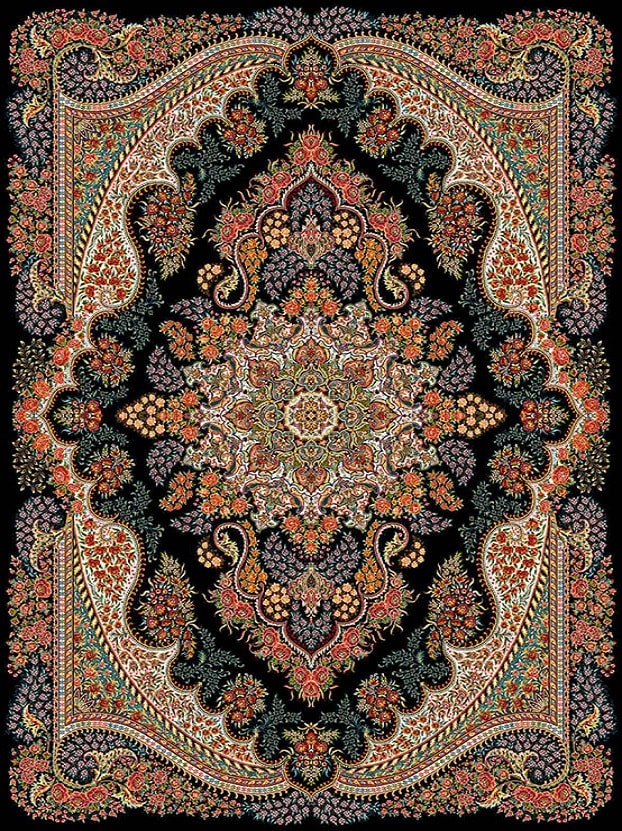
In conclusion, it is important to note that these designs are widely used in both handmade and machine-made Persian carpets. From this perspective, there is no fundamental difference between the two when it comes to design. Therefore, in presenting these patterns, examples from both machine-made and handmade carpets have been included.
However, one must not forget that a handwoven Persian carpet, crafted with an authentic Iranian design, using natural fibers and dyes, is a priceless treasure—one that has no equal anywhere in the world.
The Ardabil Carpet is the oldest rug in the world and is preserved at Victoria and Albert Museum in London. A replica of the carpet has been woven in its place of origin, at the Sheikh Safi al-Din Tomb in Ardabil.
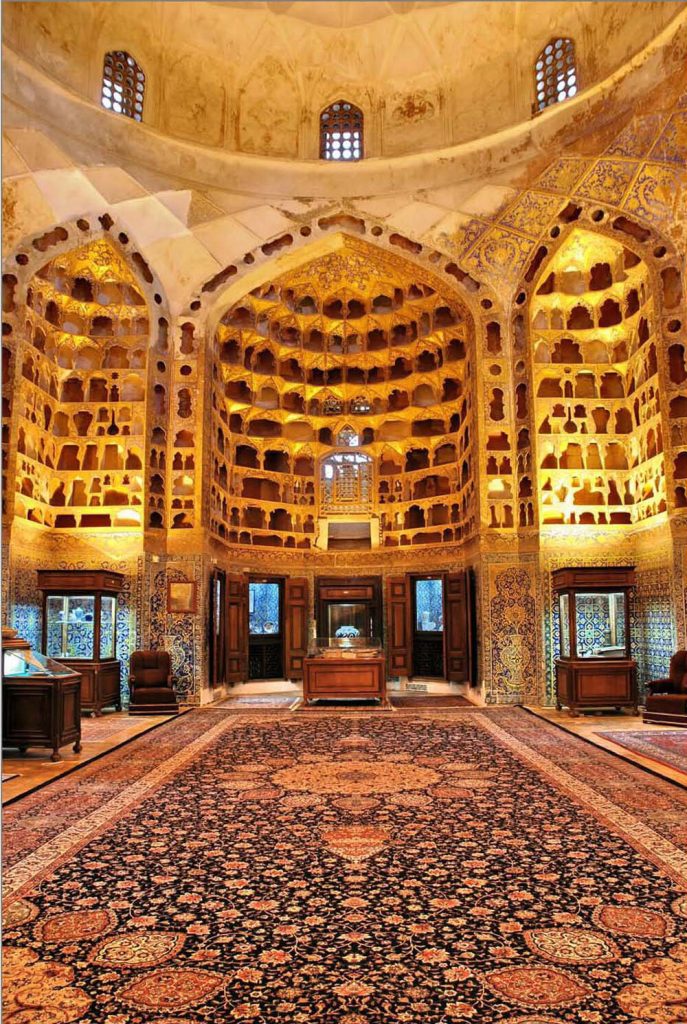
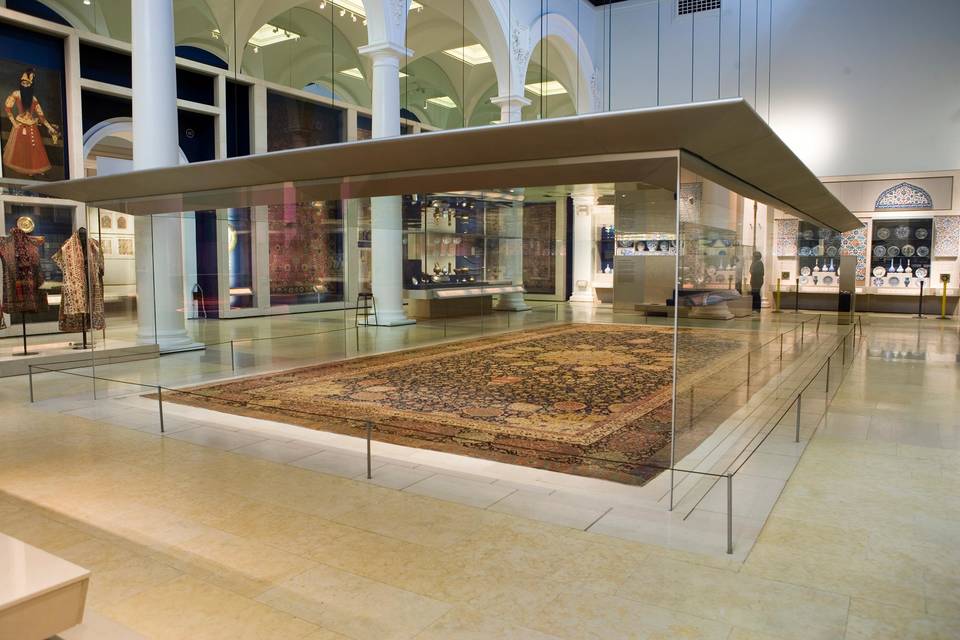

Leave a Reply